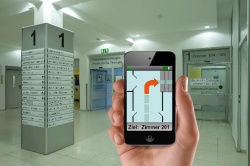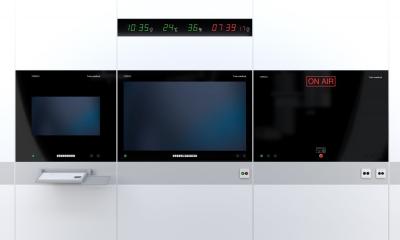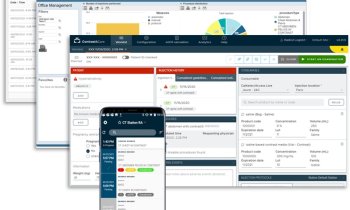2-D building navigation
People are confronted daily with finding their way in new buildings and building complexes. Generally these are intricate, have numerous sections distributed among different houses and/or floors. Whether in hospitals, rehabilitation clinics, airports, or other large building complexes, finding the way to a particular destination can be an extremely difficult or even an impossible undertaking.


Paradoxically, it’s the visitor, customer or patient who generally pose the first barrier to reach his/her destination. He or she arrives at the building in haste and is emotionally and cognitively diverted. In this situation, site plans, information signs and even electronic displays put too high a demand on the first-time visitor. Stress levels increase, with a patient losing orientation and the way to his/her destination, thus arriving late for the appointment or therapeutic session.
Günther Ortmann embarked on a search for an effective solution to this problem, which soon enough proved a real challenge: no single solution available today on the market could fulfil the primary requisites of the intended application: a practical -- easy on the user and the system operator-- and safe solution for hospitals and large medical facilities.
He identified the requisites clearly for such a system after extensive discussions with customers and users: the intended system should require no technical know-how whatsoever on the user’s side (patient, visitor, customer, etc.); its operation should be as simple as possible for people of all ages, with particular consideration for the demographic group ‘60 plus’, which is of constantly growing in importance.
With these initial insights, definitions and ideas for the development of an innovative building navigation system, he approached the Fraunhofer Institute for Photonic Microsystems in Dresden, Germany. There, engineers Hans-Jürgen Holland and Dr Nicolas Gay quickly grasped the actual demand and huge potential of the idea, leading to a collaboration between Günther Ortmann, as project leader with focus on acquisition and distribution, and the Fraunhofer Institute for Photonic Microsystems, as system developer and supplier.
After detailed examination of the undertaking, which included a feasibility study, followed technical development that led to the 2-Dimensional Building Navigation System –or 2D-GN (German short form). The 2D-GN system not only fulfils the accessibility and usability requirements detailed above but also constitutes an extendable platform for innumerable future applications.
The actual operation of the 2D-GN system is remarkably simple: When the first-time visitor, for instance a patient, arrives at a hospital or medical facility, he/she receives a 2D-GN mobile unit at the reception desk. After patient registration, the receptionist types in the 2D-GN mobile unit information regarding the attending physician and destination within the building complex. The 2D-GN mobile unit then employs signals from a wireless local-area network (WLAN) infrastructure to compute its exact position, leading the patient quickly and exactly to the desired destination.
2D-GN is based on robust mobile navigation units for in- and outdoor use. A 2D-GN mobile unit describes the way to a given destination via spoken and written multilingual instructions, 2-D graphics, plus visual and acoustic cues. To compute a route, the system also takes into account factors such as barrier-free and accessibility constraints, shortest or easiest route, forbidden and restricted areas, intermediate destinations and appointment times, to name but a few considerations.
A mobile unit displays its current position by means of a map with varying degrees of detail (as much as the user requires/demands). Furthermore, the user can always establish a direct link to a central operator for further assistance. A dynamic guidance feature enables the user to find additional points-of-interest (POI): pressing the symbol ‘WC’, for example, suspends the current route and leads the user to the nearest toilet, after which the mobile unit proceeds to the original destination.
The system is basically made up of WiFi-enabled mobile navigation units, a monitoring station and WLAN hot-spots, used as beacons by the positioning algorithm and for the exchange of on-demand information.
The 2D-GN system was developed under strict compliance with the German and European EMC regulations in medical facilities, thus qualifying its use for numerous other private and public application areas. Every mobile unit counts with detailed plans of the building, which, combined with a built-in real-time location algorithm, enables the accurate positioning of the mobile unit.
Because 2D-GN relies for its operation on an unmodified WLAN infrastructure, it is possible to offer the user additional services, such as Internet access, mobile telephony, on-demand music streaming, e-mail, mobile unit-to-mobile unit communication, VoIP, instant messaging and other data transfer services. For instance, large cruise liners could offer passengers not only regular mobile telephone services (cell phones are useless where a mobile telephony infrastructure is unavailable), but also event lists, coming attractions, restaurant menus, individual and group games, special offers, day excursions and other personalised services. Moreover, 2D-GN can prove very useful when quick communication of safety-relevant information and indications become necessary.
From its initial conception, 2D-GN was developed around a proven software architecture.
So the system, depending on the mobile unit of choice, relies upon Google’s Android or Apple’s iOS operating systems, both robust descendants of Unix, an extremely reliable operating system used in critical applications. For the system owner this translates into additional reliability, safety, data security and the possibility of performing remote maintenance with minimal operation expenses. The system was conceived with the consideration of a continuous development of the underlying infrastructure (hospitals, buildings, cruise liners, airports, etc.).
Modifications on the facility architecture, changes or improvements on the wireless networks and the addition of novel, enhanced, or newer services can be easily incorporated in a 2D-GN system thanks to its versatile concept.
2D-GN systems also offer effective mechanisms for theft protection and against mobile unit manipulation -- welcome features in open facilities and/or when stringent control of mobile units is not feasible. To this extent, the monitoring station is equipped with tracking capabilities, permitting the exact localisation of individual mobile units. These become unusable as soon as they are beyond the wireless network for which they were intended. In addition, every unit has safety features that render them unusable if manipulation is attempted.
Inevitably, this article has included a limited number of applications for 2D-GN systems, focusing on hospitals, rehabilitation centres and other healthcare facilities. Many other large buildings etc. could benefit from their use, for first-time visitors to make their way to their final destinations without frustration. Should this first-time experience of prospective customers, patients or visitors begin this way? The answer is a clear and categorical NO: the 2D-GN 2-Dimensional Building Navigation system can be an integral part of this experience and thus turn it into a very positive event.
Details: www.2D-GN.de
Source: The Fraunhofer Institute for Photonic Microsystems IPMS. Günther Ortmann, 2D-GN Project Manager, Marketing. Dr.-Ing. Nicolas Gay, 2D-GN Research and Development. Institute Head: Prof. Dr.-Ing. Hubert Lackner.
International contact: Dipl.-Ing. Hans-Jürgen Holland, Assistant Head of WMS Business Sector. hans-juergen.holland@ipms.fraunhofer.de
25.02.2011











